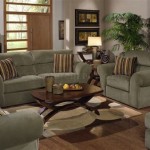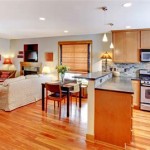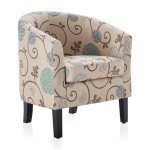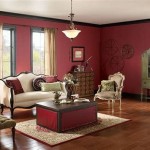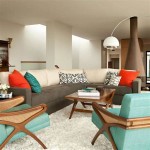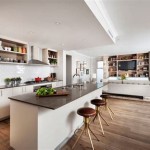```html
Interior Design for Apartment Living Rooms: Maximizing Space and Style
The apartment living room often serves as a multi-functional space, acting as a living area, entertainment hub, and sometimes even a home office. Effective interior design transforms this space into a comfortable and stylish environment that reflects the resident's personality while maximizing limited square footage. Successful apartment living room design requires careful planning, strategic furniture selection, and a thoughtful approach to color, lighting, and accessories.
Optimizing Space Through Scale and Layout
One of the primary challenges in apartment living room design is dealing with spatial constraints. Selecting furniture appropriate to the room's dimensions is crucial. Oversized pieces can overwhelm a small space, making it feel cramped and uncomfortable. Conversely, furniture that is too small can appear insignificant and disproportionate. A modular sofa, for instance, offers flexibility and can be configured to fit the specific layout of the room. Wall-mounted shelves and floating cabinets help to keep the floor clear, creating a sense of spaciousness.
The layout of the furniture significantly impacts the flow and functionality of the living room. Consider the natural traffic patterns and arrange furniture to facilitate easy movement. Avoid blocking walkways with large pieces of furniture. In smaller apartments, a multi-functional approach is beneficial. A coffee table with built-in storage can serve as both a surface for drinks and a place to store magazines or blankets. A console table behind the sofa can act as a room divider while providing additional storage and display space.
Employing vertical space is another effective strategy for maximizing space in apartment living rooms. Tall bookshelves, floor-to-ceiling curtains, and gallery walls draw the eye upward, creating the illusion of height. Mirrors strategically placed on walls can reflect light and visually expand the room. Proper space planning should always prioritize functionality. Understand how the room will be used and allocate space accordingly. For example, if the apartment dweller enjoys entertaining, ensure there is ample seating and a comfortable gathering area.
Careful consideration should be given to the placement of the television. Mounting a television on the wall not only saves floor space and offers a streamlined look; it also allows for better viewing angles and can minimize glare. When placing the television, avoid positioning it directly opposite a window, as the incoming light can cause reflections and impair the viewing experience. Cable management is also important for creating a clean and organized living room space. Employing cable organizers, cord covers, or concealing cables behind furniture will help to maintain a visually appealing environment.
Harnessing Color, Light, and Texture
The color palette of an apartment living room significantly influences the overall ambience. Lighter colors tend to make a space feel larger and brighter, while darker colors can create a more intimate and cozy atmosphere. Neutral shades, such as white, beige, and gray, are versatile and can be easily paired with accent colors. These colors allow you to add personal touches to the space through textiles, accessories, and artwork without overpowering the room's overall feel.
Strategic use of accent colors can add depth and personality to the living room. Consider using bold pops of color on throw pillows, rugs, or artwork to create visual interest. An accent wall can also be a striking focal point. However, it's essential to use accent colors sparingly to avoid overwhelming the space. A 60-30-10 rule can be helpful when planning a color scheme: 60% of the room should be the dominant color, 30% should be a secondary color, and 10% should be an accent color. This creates a balanced and harmonious color scheme.
Lighting is a critical element which will impact how a space feels. Natural light is always preferable, so take advantage of any windows by keeping them unobstructed. Supplement natural light with a combination of ambient, task, and accent lighting. Ambient lighting, such as overhead fixtures or recessed lighting, provides general illumination for the room. Task lighting, such as floor lamps or table lamps, provides focused light for reading or other activities. Accent lighting, such as spotlights or picture lights, highlights specific features of the room, like artwork or architectural details. Layering different types of lighting creates a more dynamic and inviting space.
The use of different textures can add depth and visual interest to the living room. Incorporate a variety of textures through furniture, textiles, and accessories. A plush rug, woven throw blankets, and linen curtains can add warmth and comfort to the space. Metal accents, such as a brass coffee table or a chrome lamp, can add a touch of sophistication. Mixing different textures creates a more tactile and engaging environment.
Well-chosen window treatments can significantly enhance the look and feel of an apartment living room. Curtains, blinds, and shades can provide privacy, control the amount of natural light entering the room, and add a decorative element. Consider the fabric, color, and style of the window treatments to complement the overall design aesthetic. Lightweight, sheer curtains can allow natural light to filter through while maintaining privacy. Blackout curtains can be useful for blocking out light and creating a dark environment for watching movies or sleeping during the day.
Incorporating Personal Style and Functionality
An apartment living room should be a reflection of the resident's personal style and interests. Incorporating personal touches, such as artwork, photographs, and collections, can make the space feel more personal and inviting. Displaying items that have sentimental value or reflect the resident's hobbies and passions can also add character to the room. A gallery wall featuring framed prints, photographs, and artwork can create a visually striking focal point.
Consider the resident's lifestyle and how they plan to use the living room when selecting furniture and accessories. If the resident enjoys reading, create a cozy reading nook with a comfortable armchair, a floor lamp, and a small bookshelf. If the resident enjoys entertaining, ensure there is ample seating and a comfortable gathering area. A bar cart or a serving tray can also be useful for serving drinks and snacks. For apartment residents who work from home, integrating a functional workspace into the living room requires careful planning. A small desk, a comfortable chair, and adequate lighting are essential.
Storage solutions are essential for keeping an apartment living room organized and clutter-free. Shelves, cabinets, and storage ottomans can help to conceal clutter and maximize space. Consider using vertical storage solutions, such as tall bookshelves or wall-mounted shelves, to take advantage of unused space. Baskets and bins can be used to organize smaller items, such as magazines, remote controls, and toys. Regularly decluttering the living room is also important for maintaining a clean and organized space.
Plants can add a touch of nature and bring life to an apartment living room. Indoor plants can help to purify the air, reduce stress, and create a more relaxing environment. Choose plants that are well-suited to the lighting conditions in the room and that are easy to care for. Succulents, snake plants, and spider plants are all good options for beginners. Consider using different types of planters and arranging plants in clusters to create a visually appealing display. Hanging plants can also be a great way to add greenery to the living room without taking up floor space.
Ultimately, designing an apartment living room involves balancing aesthetics with functionality. Prioritizing organization, selecting the appropriate scale of furniture, and strategically utilizing color and light all contribute to creating a stylish, comfortable and livable apartment space.
```:max_bytes(150000):strip_icc()/SFinteriors-27-c01c7c29bea14f859c0f2093ca2092bc-233015c904954d54b4fb59e7bb037629.jpeg?strip=all)
34 Small Apartment Living Room Ideas To Maximize Space And Style

Modern Apartment Decor How To Decorate Your Be Unique

A Stylish Modern Apartment Interior Project In South

34 Apartment Decorating Ideas To Personalize Your Rental

8 Beautiful Living Room Designs N Apartments In 2024
:max_bytes(150000):strip_icc()/MED3F21C18FF61248DEB3A1AEF292B91CB2-9186a60309864a5fa10aece16074f969-e1f72fef243046ecbb1ec5dbd394105c.jpeg?strip=all)
34 Small Apartment Living Room Ideas To Maximize Space And Style

A Bright And Comfortable Apartment Interior Design In Madrid

Modern Luxurious Apartment Interior Design Ideas Archid

7 Apartment Decorating And Small Living Room Ideas The Anastasia Co Decor Rooms

12 Beautiful Apartment Living Room Design Ideas She Interior


